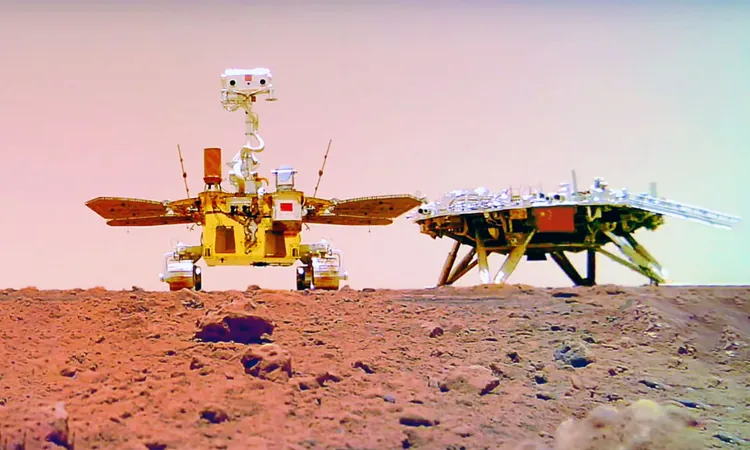
Groundbreaking Discovery: Zhurong Rover Unveils Evidence of Ancient Ocean Shoreline on Mars!
2024-11-26
Author: Ling
The saga of Mars and its watery history takes an astonishing turn with the revelations made by the Chinese Mars rover Zhurong, raising more questions than answers about the Red Planet’s potential for life.
Landed in southern Utopia Planitia in May 2021, Zhurong, now non-operational, embarked on its mission with remarkable objectives. Researchers led by Bo Wu from Hong Kong Polytechnic University assert they have discovered compelling evidence of an ocean shoreline, suggesting that a vast body of water once enveloped the northern lowlands of Mars.
Introducing Zhurong: China’s Trailblazer in Martian Exploration
Zhurong, weighing around 240 kilograms (530 lbs) — roughly comparable to a small car — serves as China's first dedicated rover to Mars, part of the ambitious Tianwen-1 mission. Equipped with an array of scientific instruments, Zhurong has the capability to navigate, analyze surface materials with its multispectral camera, and delve up to 100 meters beneath the Martian surface using ground-penetrating radar.
These advanced tools facilitate extensive geological studies, enabling the rover to capture high-resolution imagery and assess rock and soil composition. Most critically, Zhurong's ground-penetrating radar is pivotal for identifying water ice and understanding the geological history hidden beneath Mars' desolate surface.
Evidence of a Martian Ocean
Mars has piqued scientific interest for decades, particularly regarding the existence of ancient oceans during the planet's early history, notably the Hesperian period around 3.7 billion years ago. Using a synergistic approach combining Zhurong’s data and remote sensing from orbiting satellites, Wu’s team identified several features around the rover's landing site indicative of past water activity.
After traversing approximately 1.2 miles, the rover has spotted geological formations such as crater-like pitted cones, sedimentary channels, and mud volcanoes. These features suggest the remnants of a once-active coastal environment, pointing to a potentially habitable shoreline.
Dating the Ancient Ocean
The researchers date this ancient ocean to about 3.68 billion years ago, based on the sediment composition in the area. Study co-author Sergey Krasilnikov noted, "The water was heavily silted, forming distinct layering structures similar to Earth’s ancient seabeds." He further elaborated that this silty water likely underwent a freezing phase lasting between 10,000 to 100,000 years, consolidating the coastlines observed today.
Imagine a vast frozen ocean lying dormant on Mars, ultimately drying up 260 million years later—an eerie scene reflecting a planet that once harbored dynamic geological activities.
Debate Among Scientists
Yet, not all experts are convinced. Benjamin Cardenas from Pennsylvania State University highlights that erosion over billions of years would have likely obliterated such delicate shoreline features. Wu acknowledges these concerns, suggesting that asteroid impacts could have resurfaced fragments of the ancient shoreline, still detectable today.
What This Discovery Means for Life on Mars
The implications of discovering ancient shorelines are profound. If Mars was once covered by oceanic bodies, could it have supported life? Water is crucial for life as we know it, which keeps scientists theorizing about the planet's biological potential.
Moreover, NASA’s Insight lander has revealed that considerable amounts of water have permeated Mars' crust, further complicating our understanding of Mars' capacity to sustain life. As Michael Manga of the University of California aptly stated, this could indicate viable conditions for life in Martian history.
What’s Next for Mars Research?
As we look towards the future, the need to return Martian samples to Earth becomes ever more pressing. China’s Tianwen 3 sample return mission -- slated for 2031 -- aims to bring back invaluable samples, potentially leading the charge ahead of NASA’s planned sample return endeavors.
Time will tell if these endeavors will yield answers to whether Mars was once teeming with life, but for now, Zhurong continues to provide invaluable insights into the Red Planet’s mysterious watery past.
Stay tuned—could we unlock the secrets of ancient Martian life within the next decade? The unfolding story of Mars is just beginning!




 Brasil (PT)
Brasil (PT)
 Canada (EN)
Canada (EN)
 Chile (ES)
Chile (ES)
 España (ES)
España (ES)
 France (FR)
France (FR)
 Hong Kong (EN)
Hong Kong (EN)
 Italia (IT)
Italia (IT)
 日本 (JA)
日本 (JA)
 Magyarország (HU)
Magyarország (HU)
 Norge (NO)
Norge (NO)
 Polska (PL)
Polska (PL)
 Schweiz (DE)
Schweiz (DE)
 Singapore (EN)
Singapore (EN)
 Sverige (SV)
Sverige (SV)
 Suomi (FI)
Suomi (FI)
 Türkiye (TR)
Türkiye (TR)